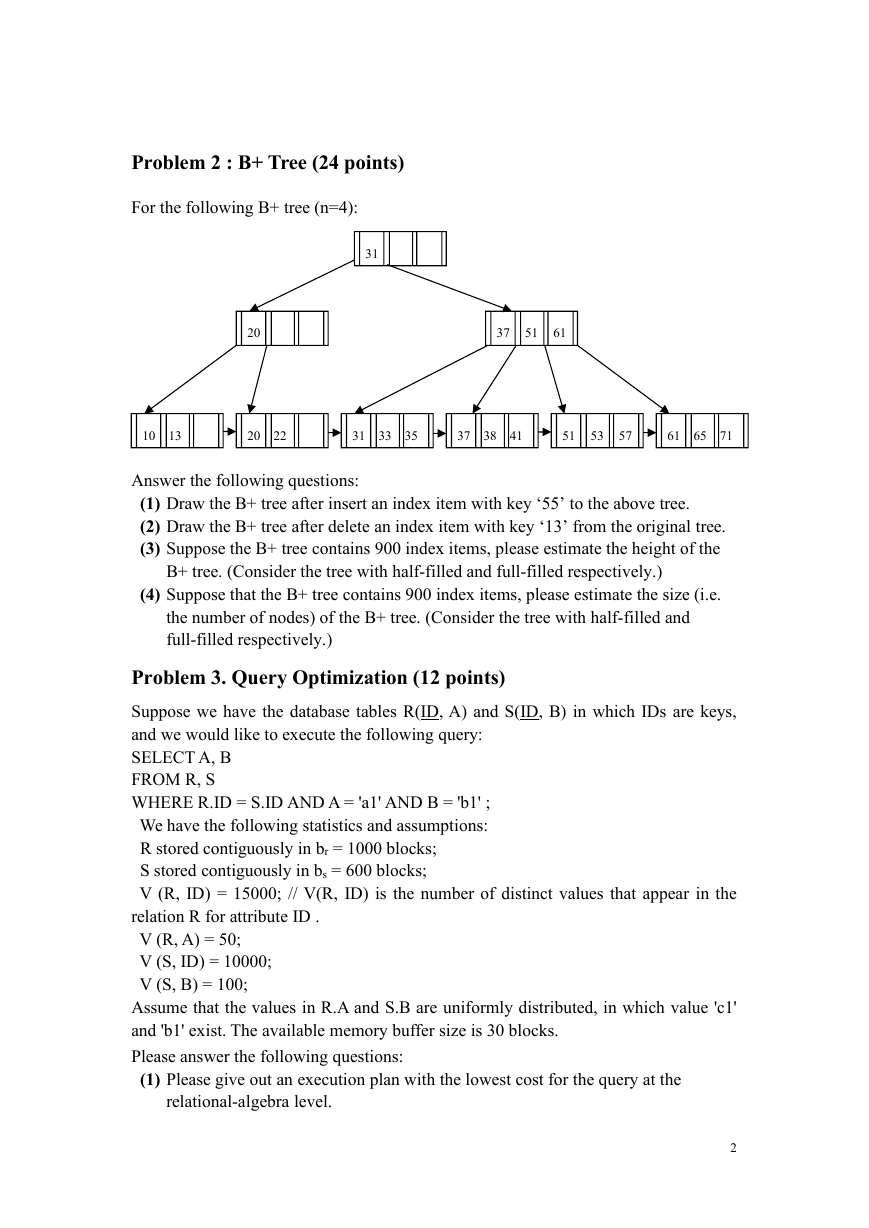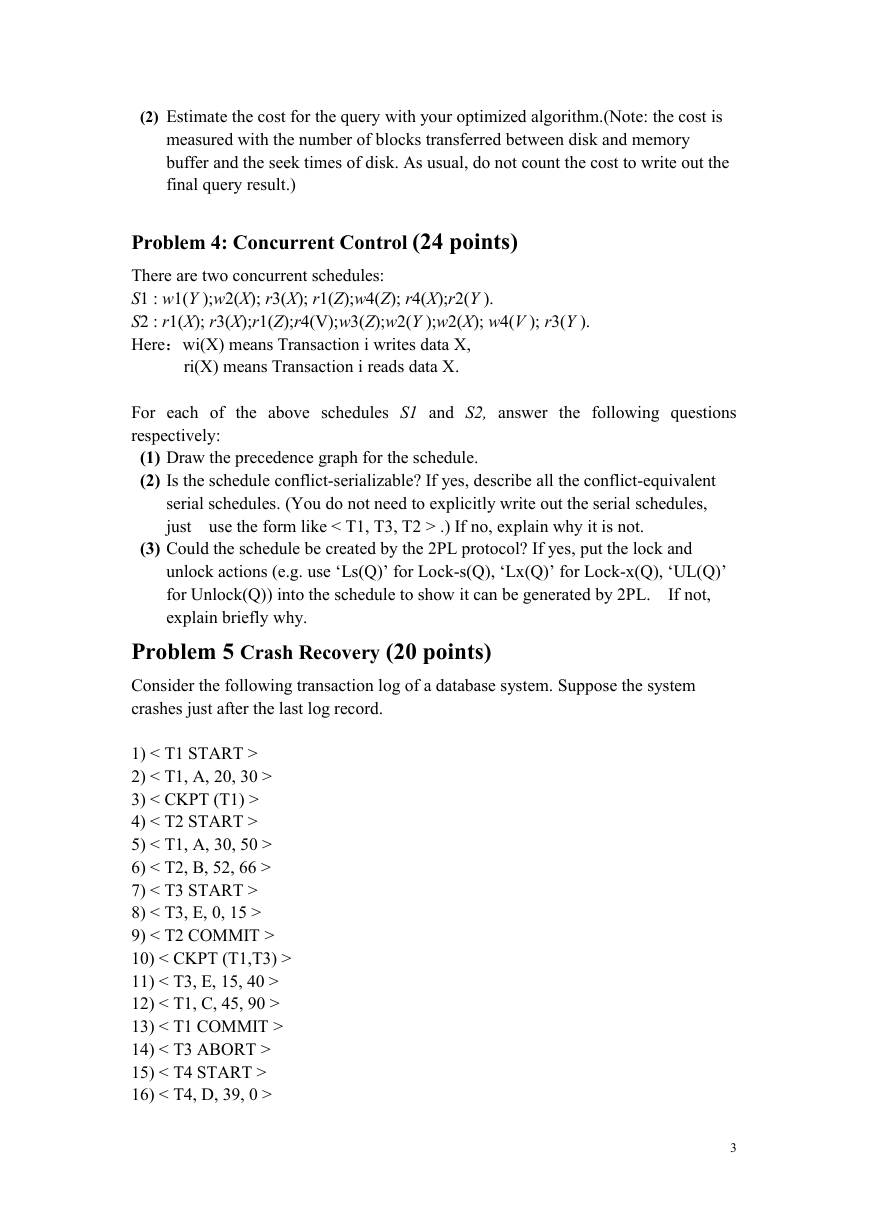Advanced Database Technology
Baseline Test
(Sample)
Problem 1 : Index and Query (20 points)
Consider the following relational schemas:
Create table emp(id char(20) primary key,
name char(30),
age int,
salary real,
address char(50),
dname char(30) ,
foreign key (dname) references dept);
Create table dept(dname char(30) primary key,
location char(50) );
Assume table emp has 6000 records, which are stored sequentially based on their
ids; table dept has 200 records, which are stored sequentially based on their dnames;
each (data or index) block can hold 2K (2048) bytes, in which 48 bytes are reserved
for the block header. The attribute with real type is 8 bytes and int type is 4bytes. No
records span two or more blocks. Each block pointer(which points to a block) is 6 bytes.
Each record pointer (which points a data record) is 8 bytes ( includes a block pointer + 2bytes
offset within a block). Index entries do not span blocks.
(1) Suppose we want to build a conventional primary index INDEX1 on emp.id
using a dense index. What is the minimum number of blocks needed for
INDEX1?
(2) For the same primary index INDEX1 on emp.id, we now want to use a sparse
index. What is the minimum number of blocks needed for INDEX1?
(3) Suppose we want to build a secondery index INDEX2 on dept.location. What
type of INDEX2 makes sense, sparse or dense? What is the minimum number of
blocks needed for INDEX2?
(4) Suppose now we want to do the natural join emp
dept. The available memory
buffer size is 10 blocks. Estimate the cost for the join, and explain the algorithm
to get the lowest cost.
1
�
Problem 2 : B+ Tree (24 points)
For the following B+ tree (n=4):
31
20
37
51
61
10 13
20 22
31 33 35
37 38 41
51
53
57
61 65 71
Answer the following questions:
(1) Draw the B+ tree after insert an index item with key ‘55’ to the above tree.
(2) Draw the B+ tree after delete an index item with key ‘13’ from the original tree.
(3) Suppose the B+ tree contains 900 index items, please estimate the height of the
B+ tree. (Consider the tree with half-filled and full-filled respectively.)
(4) Suppose that the B+ tree contains 900 index items, please estimate the size (i.e.
the number of nodes) of the B+ tree. (Consider the tree with half-filled and
full-filled respectively.)
Problem 3. Query Optimization (12 points)
Suppose we have the database tables R(ID, A) and S(ID, B) in which IDs are keys,
and we would like to execute the following query:
SELECT A, B
FROM R, S
WHERE R.ID = S.ID AND A = 'a1' AND B = 'b1' ;
We have the following statistics and assumptions:
R stored contiguously in br = 1000 blocks;
S stored contiguously in bs = 600 blocks;
V (R, ID) = 15000; // V(R, ID) is the number of distinct values that appear in the
relation R for attribute ID .
V (R, A) = 50;
V (S, ID) = 10000;
V (S, B) = 100;
Assume that the values in R.A and S.B are uniformly distributed, in which value 'c1'
and 'b1' exist. The available memory buffer size is 30 blocks.
Please answer the following questions:
(1) Please give out an execution plan with the lowest cost for the query at the
relational-algebra level.
2
�
(2) Estimate the cost for the query with your optimized algorithm.(Note: the cost is
measured with the number of blocks transferred between disk and memory
buffer and the seek times of disk. As usual, do not count the cost to write out the
final query result.)
Problem 4: Concurrent Control (24 points)
There are two concurrent schedules:
S1 : w1(Y );w2(X); r3(X); r1(Z);w4(Z); r4(X);r2(Y ).
S2 : r1(X); r3(X);r1(Z);r4(V);w3(Z);w2(Y );w2(X); w4(V ); r3(Y ).
Here:wi(X) means Transaction i writes data X,
ri(X) means Transaction i reads data X.
For each of the above schedules S1 and S2, answer the following questions
respectively:
(1) Draw the precedence graph for the schedule.
(2) Is the schedule conflict-serializable? If yes, describe all the conflict-equivalent
serial schedules. (You do not need to explicitly write out the serial schedules,
just use the form like < T1, T3, T2 > .) If no, explain why it is not.
(3) Could the schedule be created by the 2PL protocol? If yes, put the lock and
unlock actions (e.g. use ‘Ls(Q)’ for Lock-s(Q), ‘Lx(Q)’ for Lock-x(Q), ‘UL(Q)’
for Unlock(Q)) into the schedule to show it can be generated by 2PL.
explain briefly why.
If not,
Problem 5 Crash Recovery (20 points)
Consider the following transaction log of a database system. Suppose the system
crashes just after the last log record.
1) < T1 START >
2) < T1, A, 20, 30 >
3) < CKPT (T1) >
4) < T2 START >
5) < T1, A, 30, 50 >
6) < T2, B, 52, 66 >
7) < T3 START >
8) < T3, E, 0, 15 >
9) < T2 COMMIT >
10) < CKPT (T1,T3) >
11) < T3, E, 15, 40 >
12) < T1, C, 45, 90 >
13) < T1 COMMIT >
14) < T3 ABORT >
15) < T4 START >
16) < T4, D, 39, 0 >
3
�
Assume the log entries are in the format .
Please answer each of the following questions:
(1) What are the values of A, B, C, D and E in the database just after system crash?
(2) Which transactions should be undone? Which transactions should be redone?
(3) What are the start and end points for undo and redo processes respectively?
(4) What are the values of A, B, C, D and E after system recovery ?
4
�








 2023年江西萍乡中考道德与法治真题及答案.doc
2023年江西萍乡中考道德与法治真题及答案.doc 2012年重庆南川中考生物真题及答案.doc
2012年重庆南川中考生物真题及答案.doc 2013年江西师范大学地理学综合及文艺理论基础考研真题.doc
2013年江西师范大学地理学综合及文艺理论基础考研真题.doc 2020年四川甘孜小升初语文真题及答案I卷.doc
2020年四川甘孜小升初语文真题及答案I卷.doc 2020年注册岩土工程师专业基础考试真题及答案.doc
2020年注册岩土工程师专业基础考试真题及答案.doc 2023-2024学年福建省厦门市九年级上学期数学月考试题及答案.doc
2023-2024学年福建省厦门市九年级上学期数学月考试题及答案.doc 2021-2022学年辽宁省沈阳市大东区九年级上学期语文期末试题及答案.doc
2021-2022学年辽宁省沈阳市大东区九年级上学期语文期末试题及答案.doc 2022-2023学年北京东城区初三第一学期物理期末试卷及答案.doc
2022-2023学年北京东城区初三第一学期物理期末试卷及答案.doc 2018上半年江西教师资格初中地理学科知识与教学能力真题及答案.doc
2018上半年江西教师资格初中地理学科知识与教学能力真题及答案.doc 2012年河北国家公务员申论考试真题及答案-省级.doc
2012年河北国家公务员申论考试真题及答案-省级.doc 2020-2021学年江苏省扬州市江都区邵樊片九年级上学期数学第一次质量检测试题及答案.doc
2020-2021学年江苏省扬州市江都区邵樊片九年级上学期数学第一次质量检测试题及答案.doc 2022下半年黑龙江教师资格证中学综合素质真题及答案.doc
2022下半年黑龙江教师资格证中学综合素质真题及答案.doc